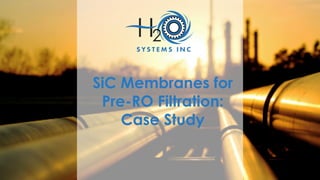SiC Membranes Pre-RO Treatment of Scrubber Effluent: Case Study
- 1. SiC Membranes for Pre-RO Filtration: Case Study
- 2. Reverse Osmosis • Technology used to remove dissolved solids and impurities from water using semi-permeable membrane. • RO membrane requires water to be under high pressure • Industrial RO systems can remove up to 99.5% of dissolved salts/suspended solids from feedwater
- 3. RO can remove key contaminants • Dissolved salts • Colloids • Organics • TSS
- 4. RO Pre-Treatment • Performance of RO System depends highly on quality of pre- filtration • Without proper pretreatment, fouling, scaling can occur causing membrane failure • Increases cleaning requirements and OPEX
- 5. Why Pre- Treatment? 1. Improved pre-filtration with more efficient removal of suspended solids results in longer operating intervals of RO system before chemical cleaning. 2. Reduced chemical cleaning means prolonged lifetime for RO membranes and reduced OPEX. 3. Prior removal of TSS reduces fouling of RO membrane. 4. Quality and capacity of RO membrane is seen.
- 6. Our Solution SiC Ceramic Membranes Ideal in scenarios with bio-fouling potential Can be cleaned with any chemicals (pH 0-14), strong oxidziers (e.g. ozone) and have high mechanical strength enabling high pressure back flush Ensures efficient cleaning and membrane selectivity at high temperatures
- 7. What can I remove? • Oil • Grease • Iron • TSS • Bacteria • Algae • Organic Matter
- 8. Why SiC Membranes • Oil repelling • Inert • Less Footprint • Longer lifetime • High Recovery • Self-cleaning All this filtration can be accomplished in 1 single step!
- 9. Why SiC over traditional methods POLYMERIC MEMBRANES ARE • Not as chemically or temperature resistant as not good (ecspecially at high temperatures of oil&gas industry) • Handle oil very poorly Polymeric membranes are • Expensive • Low water flux
- 10. 0.04 Micron 3,000 L/(m2 hr) 4,000 L/(m2 hr) 10,000 L/(m2 hr) >12,000 L/(m2 hr) FluxPore size 0.1 Microns 1 Microns 3 Microns Filtration capability
- 11. How it works Feed flow is tangential to the surface of the membrane in order to sweep rejected particles and solutes away CROSS FLOW FILTRATION
- 12. Case Study: Filtration of Scrubber Water Application: • Wet scrubbers used for cleaning exhaust gases to reduce air pollution • Harmful particles transferred from gas phase to scrubbing solution • Liquid solution contains high amount of heavy metals -> must be removed to meet discharge limits Challenge: • Scrubber water has fluctuating heavy metal conc. • High T • Acidic or alkaline feedwater • High fouling potential due to scaling
- 13. Case Study: Filtration of Scrubber Water Test: H2O Systems to use SiC membranes to treat scrubber wastewater at Danish Biomass Fired Powerplant with 2 objectives: • Fulfill discharge requirements • Re-use scrubber wastewater as RO feedwater Results:
- 14. Conclusion • SiC membrane installation capable of providing treated water that meets discharge legislation requirements • RO feed water quality is met (SDI <3) • Improved quality of treated water (Table 1) • Reduced footprint of filtration unit (35 m3/h system is 8 m2 with a height of 2.2 m) • No need for chemical dosing/sludge disposal • Chemical resistance of membrane protects against highly corrosive scrubber water
- 15. Future Outlook • SiC membranes allow for reduced installation costs with a smaller footprint and can meet future legislation requirements. • Re-use of treated water in a closed loop reduces OPEX and environmental impact • Polluted liquid treated by SiC membranes followed by RO membrane -> enables re-use of treated water • 80% reduction of clean water use • Operating costs associated with waste discharge/ sludge handling reduced by 90%
- 16. Next Steps • Meeting • Submit water analysis • Proposal and savings • Trial • Full systems intergration
















